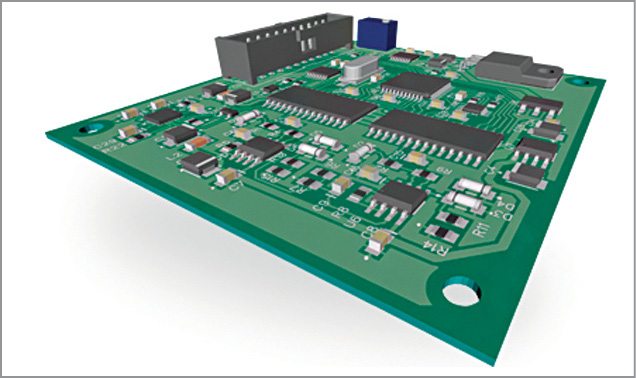Export for manufacturing. Gerber files for printing PCBs can be exported layer-by-layer or in batches with DipTrace. You can even specify details like what components need to be exported to the files, what accuracy is needed and preview to visualise your configuration.
Numerical control (N/C) drill file that needs to be sent in to the manufacturer can also be generated with just a few clicks. Also, with 3D-preview-&-export module, you can see the 3D model of the board with all components installed, rotate it, change parameters to see the effect and export 3D PCB in STEP format for mechanical computer-aided design integration.
Efficient and easy to use
Having seen how you can use DipTrace to design PCBs faster and better, one might wonder how the tool manages to do what it does. Let us now take a look at three features that make the design tool work its magic.
Component editor. Manage component library, make new components and edit old ones with this editor. You can design the component, choose its properties and functioning details.
For chips, you have the choice of different kinds of packages, too. You can even group pins based on their functionality and handle these as a single unit.
Pattern editor. Every component has a particular pattern (footprint) on the PCB on which it is placed. This is like the allotted place with required connections in order. This editor helps you make and edit these patterns, letting you specify the parameters. Pad specifications like position, shape and numbering can also be worked around using templates and special features.

Pattern editor also allows you to connect patterns to your 3D model for a wholesome picture.

Cross-module library management. With exclusive sections for components, patterns and 3D models, all libraries in DipTrace are organised into groups where both components and patterns can be stored. The structure of the libraries gives easy access to components. Also, with an efficient filter, you can search these by reference, designator, type or value.
Learn from first-hand experience
There are two factors that seem to be making users choose DipTrace. One is the graphical user interface (GUI) that is easy to use, easy to learn, intuitive and familiar. The other factor is export/import feasibility.
The process adds no complications and thus, users find DipTrace easy to work with when they want to use multiple software for different areas of expertise, like exporting files to Spectre for auto-routing.
There are also users who stick to the software as developers are active on various forums. Certainly makes it easy when you have doubts you want answered quickly, would you not say?
Interestingly, you can install DipTrace on multiple systems, but only one copy of the software should run at a time. A user on Parallax forum says, “I use DipTrace but also use Eagle to review designs for customers that use Eagle. I would definitely say that DipTrace is better of the two. I still struggle with certain things in Eagle, but DipTrace was easy to use from the get-go. I am still learning all the tricks, but throwing together a basic PCB in DipTrace is super easy and requires very few intelligence quotient points.”
DipTrace developers are open to user complaints and appropriately react to the engineering community with improvements and updates.
Make the most of updates
DipTrace enjoys huge community support and offers good support to its users. The version with this month’s DVD is DipTrace 2.4. Get accustomed to it quickly as the next version 2.9 is in Beta stage. It includes support for differential-pair routing, not just in designating nets as pairs but using it as a single unit while routing manually.
An interesting way of working with this tool is to use hot-keys or keyboard shortcuts. The latest version allows you to customise your hot-keys according to your comfort. With additional support to the modern open database (ODB++) and new-generation Gerber X2 formats, PCB manufacturing seems to be at its best.
The author is a technical journalist at EFY










